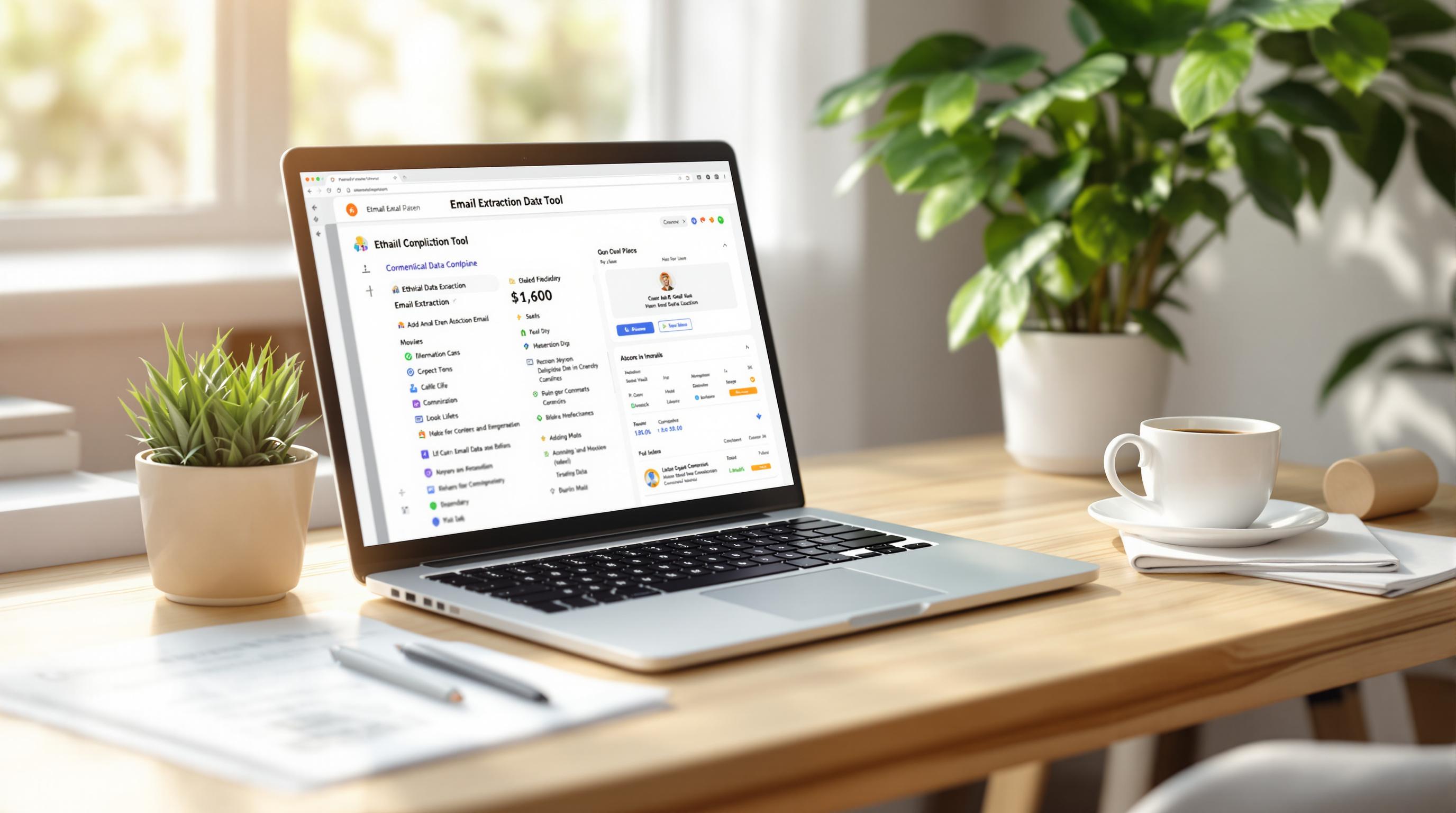Want better email engagement? Start A/B testing your email layouts. Here's why it works and how to do it:
- What is A/B Testing? Compare two email versions (e.g., different layouts, CTAs, or designs) to see which performs better.
- Why it matters: Testing helps improve open rates, click-through rates, and conversions by identifying what resonates with your audience.
- Key elements to test: Subject lines, visual design, CTA placement, content structure, and mobile responsiveness.
- Steps to run tests:
- Pick one element to test (e.g., CTA placement).
- Split your audience into two equal groups.
- Compare results using metrics like open rates or clicks.
- Tools to use: Platforms like Mailchimp, HubSpot, or Salesforce simplify A/B testing.
Quick Tip: Always test one variable at a time and ensure your sample size is large enough for reliable results. Regular testing leads to better email strategies over time.
What You Need to Know About A/B Testing for Emails
What Is A/B Testing?
A/B testing involves comparing two versions of an email to see which one performs better based on metrics like open rates and click-through rates [3][6]. It focuses on changing a single variable to measure its impact.
Here are some layout elements you might test:
| Layout Element | Version A | Version B |
|---|---|---|
| Header Design | Banner image | Product thumbnails |
| Content Structure | One column | Two-column layout |
| CTA Placement | Top of email | Bottom of email |
| Visual Elements | More images | More text |
Why Test Email Layouts?
Testing layouts helps you figure out what grabs your audience's attention and keeps them engaged. The structure and design of your email can directly influence click-through rates and conversions [1][4].
Some key factors to consider:
| Factor | Impact on Engagement |
|---|---|
| Design Order | Helps guide readers through key content |
| Content Flow | Affects how long readers stay interested |
| Mobile-Friendly Design | Ensures easy access across all devices |
| White Space Usage | Improves readability and focus |
When testing layouts, keep these tips in mind:
- Test one element at a time for clear results [4][5].
- Make sure your sample size is big enough to get reliable data [4][5].
- Track metrics that match your campaign's specific goals [3][6].
With these basics covered, you're ready to dive into setting up and running effective A/B tests.
Steps to Run A/B Tests for Email Layouts
Choosing What to Test
Start by pinpointing specific layout elements that might influence how your audience interacts with your emails. Prioritize elements tied to user engagement and conversion rates:
| Layout Element | Testing Options | Impact Area |
|---|---|---|
| CTA Button | Size, Color, Placement | Click-through rates |
| Content Structure | Single vs Multi-column | Reader engagement |
| Visual Hierarchy | Image placement, Text blocks | Information flow |
| Mobile Design | Responsive vs Fixed | Device compatibility |
Once you've identified the elements you want to experiment with, it's time to set up your A/B test.
Creating the Test
Running an A/B test successfully means careful planning and execution. Start by splitting your audience into two groups that are statistically comparable.
1. Define Your Hypothesis
Craft a clear hypothesis. For example: "Placing the CTA above the fold will boost click-through rates by making it more visible."
2. Segment Your Audience
Split your email list into two equal groups to ensure fair comparisons [7].
3. Create Distinct Versions
Make sure only one element is different between the two email versions. This ensures you can attribute any performance change to that specific variable [4].
Tips for Running Tests
Timing Is Key: Send both email versions at the same time to eliminate timing-related biases [4].
Sample Size Guidelines:
| Total Email List Size | Minimum Test Group Size |
|---|---|
| Under 5,000 | 25% of total list |
| 5,000-10,000 | 20% of total list |
| Over 10,000 | 15% of total list |
Statistical Accuracy: Many email platforms include tools to help you determine when your results are statistically valid [3].
Track Multiple Metrics: While your primary metric is the focus, secondary metrics can offer extra insights into user behavior and overall campaign success:
| Primary Metric | Secondary Metrics |
|---|---|
| Open Rate | Engagement Duration |
| Click Rate | Device Usage |
| Conversion | Forward Rate |
Once your test concludes, the next step is diving into the data to uncover actionable takeaways.
How to Review and Use A/B Test Results
Metrics to Monitor
Pay attention to these key performance indicators (KPIs) to evaluate how well your layout performs:
| Primary Metric | What It Measures | Target Range |
|---|---|---|
| Open Rate | How accessible your email is and the impact of its subject line | 15-25% |
| Click-Through Rate (CTR) | Engagement with the layout and the effectiveness of your call-to-action (CTA) | 2-5% |
| Bounce Rate | Email deliverability and the quality of your subscriber list | Under 2% |
| Conversion Rate | The percentage of users completing your desired action | Varies |
Tip: Benchmarks differ by industry, so use these as general guidelines. These metrics can help pinpoint areas for improvement, like tweaking your CTA placement to boost CTR.
Understanding the Results
Interpreting A/B test results means looking at how metrics relate to each other. For instance, if Layout A gets more opens but Layout B generates more clicks, you might want to focus on Layout B's design elements for better engagement [2].
To draw accurate conclusions, follow these steps:
1. Check Statistical Significance
Ensure the results aren’t random. Many email platforms, like Mailchimp and Mailjet, offer built-in tools to calculate this automatically [2].
2. Evaluate Sample Size
A minimum of 1,000 subscribers per variant is ideal for reliable results [1]. If your list is smaller, extend the test duration to gather more data.
3. Account for Seasonal Trends
Factor in external influences like holidays, promotions, or events that could have impacted user behavior during the testing period [3].
Common Mistakes to Avoid
Jumping to Conclusions: Always wait for statistically significant results before making changes. Acting too soon could lead to misguided decisions.
| Testing Duration | Sample Size | Confidence Level |
|---|---|---|
| 24-72 hours | 500+ subscribers | 90-95% |
| 1 week | Fewer than 500 subscribers | 85% |
Overlooking Deeper Insights: Don’t stop at open rates. A higher open rate might seem positive, but if clicks or conversions are low, the email isn’t performing as well as it could [1].
Ignoring External Influences: Be mindful of factors like holidays, promotions, or industry-specific events that could skew your test results [3].
sbb-itb-8abf799
Using A/B Testing Insights to Improve Emails
Applying Winning Elements to Future Emails
Keep a record of what works. Document which layouts, visuals, and content choices consistently drive engagement. This approach ensures future email designs are informed by proven strategies while keeping your brand identity intact.
| Element Type | Testing Focus | Implementation Strategy |
|---|---|---|
| Layout Structure | Single vs. Multi-column | Use the winning format for similar campaigns. |
| Visual Elements | Image placement & sizing | Standardize effective image arrangements. |
| CTA Design | Button style & position | Build templates with successful CTA patterns. |
| Content Flow | Content hierarchy | Create content blocks based on engagement data. |
By using modular templates and reusable components, you can seamlessly incorporate high-performing elements into your emails without compromising brand consistency.
Why Regular Testing Matters
Testing consistently is key to keeping your email campaigns effective. Set up a monthly schedule to test one element at a time, such as subject lines, layouts, CTAs, or content structure. This focused approach helps you uncover trends while avoiding audience fatigue.
"The key to A/B testing is to learn from what works and what doesn't and to continue to iterate based on your results." - Mailjet Blog [4]
When running ongoing tests, keep these tips in mind:
- Test one element at a time to ensure clear results. [4][7]
- Strike a balance in testing frequency to avoid overwhelming your audience.
- Consider seasonal trends when evaluating your data. [1]
Regular testing doesn’t just boost individual campaigns - it lays the groundwork for stronger, more engaging email strategies over time. To streamline this process, explore tools designed to simplify A/B testing and optimize your emails.
Tools to Help with A/B Testing and Email Campaigns
Platforms with Built-in A/B Testing Features
Many email marketing platforms come equipped with A/B testing tools, making it easier for businesses to refine their campaigns. Here's a breakdown of some popular platforms and what they offer:
| Platform | Key Testing Features | Best For |
|---|---|---|
| Mailchimp | Test subject lines, content, sender names | Small businesses starting with A/B testing |
| HubSpot | Multi-variable testing, detailed analytics | Mid-sized companies needing in-depth data |
| Salesforce | Advanced segmentation, automated testing | Large-scale enterprise campaigns |
| Mailmodo | Visual editor, step-by-step setup | Teams new to email testing |
| Benchmark | Multi-variable testing, drag-and-drop interface | Visual-focused marketers |
These platforms are designed to simplify the testing process, even for users without technical expertise. Whether you need basic A/B comparisons or more advanced multi-variable tests, there’s a tool to fit your business size and goals [2][3].
While these platforms are great for testing, ensuring you have a solid email list is just as important for meaningful results.
Email Extractor Tool - Streamline List Building with AI
To support effective A/B testing, Email Extractor Tool offers an AI-driven approach to building email lists. This tool is ideal for marketers who want to expand their audience quickly and efficiently.
By automatically identifying and extracting emails from web pages, it helps businesses keep their contact lists up to date. You can easily export these lists to your preferred platform, making the process from lead generation to testing seamless.
With 71% of companies already using A/B testing in email marketing [4], combining strong list-building tools like this with robust testing platforms ensures a well-rounded strategy. When deciding on tools, think about your campaign size, the features you need, and your budget to find the best fit.
Why A/B Testing Boosts Email Engagement
A/B testing plays a key role in refining email marketing campaigns. By testing different email layouts and elements, marketers can make informed decisions that lead to better outcomes.
Key Takeaways
Improving email marketing performance hinges on understanding your audience and making adjustments based on testing. Here's a quick overview of what matters:
| Factor | How to Apply It |
|---|---|
| Targeting and Engagement | Experiment with different elements to learn what your audience prefers |
| Making Data-Driven Choices | Use adequate sample sizes to ensure reliable results |
| Ongoing Improvements | Apply findings from tests to continually enhance campaigns |
To make A/B testing work for you, focus on these core practices:
- Test One Element at a Time: Isolate variables like subject lines or call-to-action buttons to pinpoint what works best [4].
- Ensure Reliable Sample Sizes: Gather enough data to draw accurate conclusions [4].
- Refine Based on Results: Use the insights from each test to improve future emails [1].
FAQs
How to do AB testing for emails?
A/B testing can help you figure out what works best in your email campaigns. It lets you test different versions of your emails to see which one gets better results with your audience.
Start by focusing on specific elements like layout, CTA (call-to-action) design, or content structure - these can directly impact engagement and conversions. The process is simple: pick one thing to test, split your audience into two groups, and measure key metrics like open rates or click-through rates to see which version performs better.
Here’s a quick guide:
| Testing Focus | Key Metrics to Track |
|---|---|
| Layout Design | Open rates |
| CTA Elements | Click-through rates |
| Content Structure | Conversion rates |
To get reliable results, make sure to:
- Use a large enough sample size
- Run tests during normal business hours or cycles
- Give the test enough time to collect meaningful data
It’s also important to test one variable at a time and ensure both groups are evenly balanced. This approach helps you gather accurate insights [4].
Regular testing keeps your emails aligned with your audience’s preferences, making your campaigns more effective over time [8]. By following these steps, you can use A/B testing to fine-tune your email strategy and boost performance.



